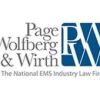By Steve Johnson, director of reimbursement consulting
We often get questions about the documentation responsibilities of non-transporting, first response entities. One recent example was this: “What are the patient care report documentation obligations for firefighters that respond to medical calls, but don’t transport patients?”
Good patient care documentation is a critical component of patient care. It does not matter whether you respond in a fire engine, a rescue truck or an ambulance. Patient care is patient care, regardless of what other services you or your organization provide.
It is important for non-transporting medical first responders to ensure that clear, complete documentation of your assessment, findings and treatment of the patient are provided to the transporting crew, as the doctors and nurses at the receiving facility will not have the opportunity to talk with you about what you saw and experienced with regard to this particular patient upon the initial arrival of patient care providers.
You had the first opportunity to talk with the patient, or their family or friends. It is important that information you have about the patient’s initial presentation, and events leading up to a request for an EMS response, as well as care provided to the patient prior to ambulance arrival be thoroughly documented. This is often important information to downstream caregivers.
If you think about it from the patient’s perspective for a moment, would it seem reasonable for a patient to assume that information they provide to the caregiver who arrived when they dialed 911 would not be given to the individuals who provide their ongoing care?
And now for a moment, think about it from the perspective of the medical team at a receiving hospital. Would it seem reasonable to assume that those caregivers would be perfectly fine with having some information about the patient’s initial presentation, condition, assessment and treatment withheld?
Hopefully, we would all agree that the answer to both of those questions is an emphatic, “No.”
Integrated patient care and documentation
Firefighters, EMS providers and other first responders are an essential part of an integrated patient care delivery system. Together, everyone shares in the responsibility to provide the highest quality patient care possible. As with many of your other areas of responsibility, communication is key to efficiency and effectiveness. And when it comes to patient care, a well-written patient care report is the best way to ensure that information is effectively and efficiently communicated, both to the transporting crew and to other downstream patient care providers.
So, really the question is this, “What are the documentation requirements of patient care providers responding to a 911 call, prior to handing off care for that patient to another individual or team?
The answer to that question is that the documentation should paint a clear picture of the following:
- The specifics of your dispatch and your response, including any delays or impediments to patient access.
- Initial impressions and patient presentation upon arrival.
- The patient’s chief complaint.
- Information gathered from family or bystanders regarding the patient’s emergency.
- Your patient assessment.
- Any treatments or procedures performed, including successful and unsuccessful procedures.
- The patient’s response to your treatments and procedures.
Of course, the documentation requirements will vary based on the amount of time that passes and the care provided prior to turning over responsibility for the patient to the responding ambulance crew. As the first responder, only you have the opportunity to document the initial patient interaction with prehospital caregivers.
As a professional patient care provider, you have a responsibility to properly and completely document all aspects of the care you provide.
The primary obligation of an individual responding to a member of the public’s request for prehospital emergency medical care is to provide safe, efficient, high-quality medical care. This includes careful attention to the details in all aspects of that patient care, including a thorough and complete patient care report.
About the author
For over 15 years, Page, Wolfberg & Wirth has been the nation’s leading EMS industry law firm. PWW attorneys and consultants have decades of hands-on experience providing EMS, managing ambulance services and advising public, private and nonprofit clients across the U.S.
PWW helps EMS agencies with reimbursement, compliance, HR, privacy and business issues, and provides training on documentation, liability, leadership, reimbursement and more. Visit the firm’s website at www.pwwemslaw.com, call 877-EMS-LAW1 (717-691-0100) to talk to any of our attorneys and consultants or email Karen Kreider kkreider@pwwemslaw.com if interested in onsite compliance or documentation training.
PWW’s Ambulance Compliance Program Tool Kit is specifically designed to deal with the new overpayment refund rules with model forms and policies, a model compliance plan, code of conduct, and compliance training program.













